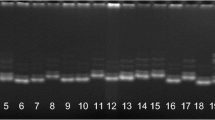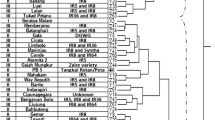Summary
The genetic characteristics and classification of 24 strains of Korean weedy rice, two strains of foreign red rice, three Japonica cultivars, one Tongil cultivar and one Indica cultivar (Oryza sativa L.) were investigated at the DNA level using the restriction fragment length polymorphism (RFLP) method. Eighty-three random combinations between six restriction enzymes and forty genomic DNA probes (RG# and KR#) were assayed. Thirty-seven (92.5%) out of the forty probes used showed polymorphisms among the 31 accessions assayed. A high level of polymorphism was found between short and long grain type Korean weedy rices, whereas fewer polymorphisms were presented among strains within each grain type. A dendrogram summarizing genetic similarity coefficients among thirty-one accessions was constructed based on their DNA polymorphisms. The Korean weedy rice strains were classified into two groups identical to the short and long grain types classified by morphological and physiological characters. From the RFLP analysis, it was deduced that the short grain strains of Korean weedy rice belonged to Japonica, while the long grain strains were closer to Indica than to Japonica, and were differentiated into a local ecotype surviving in the growth conditions in the southern part of the Korean peninsula.
Similar content being viewed by others
References
Cho J.H., H.S. Suh, T.Y. Chung & M.Y. Eun, 1993. Collection and evaluation of Korean red rices IV. Affinity of Korean red rices with cultivars and foreign red rices based on isozyme polymorphism. Korean J. Breed 24: 327–334.
Eun M.Y., Y.K. Kim, Y.G. Cho, Y.W. Kim, T.Y. Chung & H.C. Choi, 1990. Classification of Korean native rice cultivars by isozyme variations. Korean J. Breed 21: 293–299.
Glaszmann J.C., 1987. Isozymes and classification of Asian rice varieties. Theor. Appl. Genet. 74: 21–30.
Hara S., 1942. Persistence of an Indica rice in Korea. Agriculture and Horticulture 17: 705–712.
Heu M.H., Y.C. Cho & H.S. Suh, 1990. Cross affinity of Korean weedy rice to the cultivars. Korean J. Crop. Sci. 35: 233–238.
Heu M.H., H.J. Koh, H.S. Suh & S.Z. Park, 1991. Indica rice grown in Korea. Korean J. Crop. Sci. 36: 241–248.
Ishii T., O. Panaud, D.S. Brar & G.S. Khush, 1990. Use of non-radioactive, digoxigenin-labeled DNA probes for RFLP analysis in rice. Plant Mol. Biol. Reptr. 8: 167–171.
Kinoshita T., 1990. Report of the committe on gene symbolization, nomenclature and linkage groups. Rice Genet. News 7: 16–50.
McCouch S.R., G. Kochert, Z.H. Yu, Z.Y. Wang, G.S. Khush, V.R. Coffman & S.D. Tanksley, 1988. Molecular mapping of rice chromosomes. Theor. Appl. Genet. 76: 815–829.
Nakano M., A. Yoshimura & N. Iwata. 1993. Phylogenetic study of cultivated rice and its wild relatives by RFLP. Rice Genet. News 9: 132–134.
Nei M., 1987. Molecular evolutionary genetics. Columbia University Press, NY, pp. 106–107.
Oka H.I., 1988. Origin of cultivated rice. Japan Scientific Societies Press, Tokyo, pp. 107–114.
Rohlf F.J., 1992. Numerical taxonomy and multivariate analysis system, NTSYS-pc program. Applied Biostatistics Inc., 3 Heritage Lane, Setauket, NY 11733.
Sokal R.R. & C.D. Michener, 1958. A statistical method evaluating systematic relationships. Univ. Kansas Sci. Bull. 38: 1409–1438.
Suh H.S. & W.G. Ha, 1993a. Collection and evaluation of Korean red rices V. Germination characteristics on different water and soil depth. Korean J. Crop Sci. 38: 128–133.
Suh H.S. & W.G. Ha, 1993b. Collection and evaluation of Korean red rices VII. Quality. Korean J. Breed 25: 121–123.
Suh, H.S. & H. Morishima, 1995. Classification of weedy rice by morphological characteristics, isozyme and RAPD. (in preparation).
Suh H.S., S.Z. Park SZ & M.H. Heu, 1992a. Collection and evaluation of Korean red rices I. Regional distribution and seed characteristics. Korean J. Crop Sci. 37: 425–430.
Suh H.S., J.H. Cho & M.H. Heu, 1992b. Collection and evaluation of Korean red rices III. Cross affinity of Korean red rices with cultivars and foreign red rices. Korean J. Breed 24: 322–326.
Ueno K., T. Sato & N. Takahashi, 1990. The indica-japonica classification of Asian rice ecotypes and Japanese lowland and upland rice (Oryza sativa L.). Euphytica 46: 161–164.
Wang Z.Y. & S.D. Tanksley, 1989. Restriction fragment length polymorphism in Oryza sativa L. Genome 32: 1113–1118.
Wang Z.Y., G. Second & S.D. Tanksley, 1989. Polymorphism and phylogenetic relationships among species in the genus Oryza as determined by analysis of nuclear RFLPs. Theor. Appl. Genet. 83: 565–581.
Author information
Authors and Affiliations
Rights and permissions
About this article
Cite this article
Cho, YC., Chung, TY. & Suh, HS. Genetic characteristics of Korean weedy rice (Oryza sativa L.) by RFLP analysis. Euphytica 86, 103–110 (1995). https://doi.org/10.1007/BF00022015
Received:
Accepted:
Issue Date:
DOI: https://doi.org/10.1007/BF00022015




